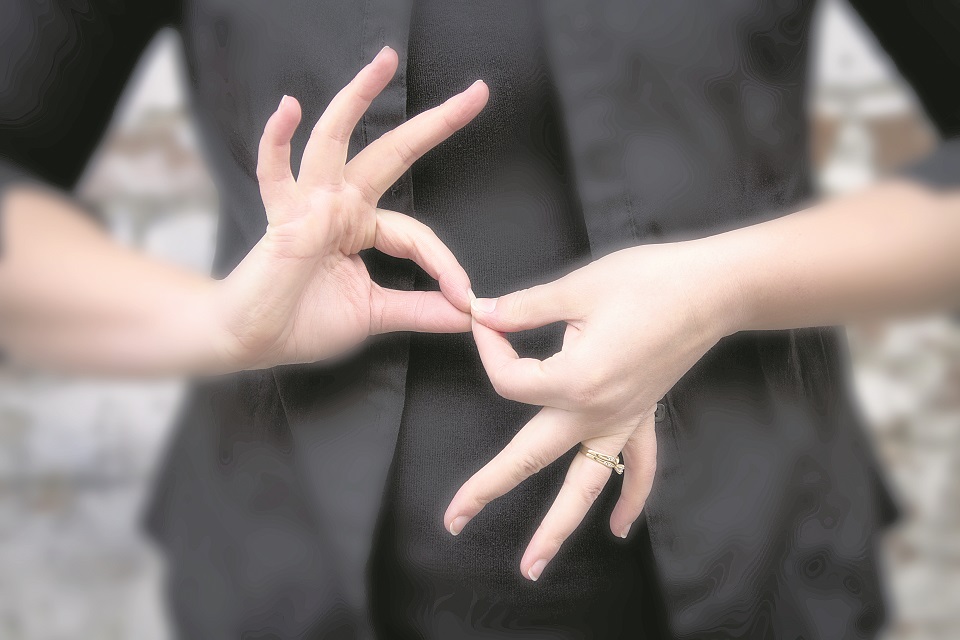
OR

Learning sign language is no different than learning a new language, except that it requires demonstrations. From explanations of each gesture, sentence formations to syntaxes and delivery, it’s best if your teacher is someone who can use both verbal and non-verbal languages.
Sign language is the major communication method among the hearing-impaired community. It can be intriguing to watch sometimes. The strange hand movements, aligning facial expressions mixed with laughter and gentle smiles—it feels like someone is not letting you in on a secret.
And that’s how it begins, the strange, all-consuming thirst of curiosity, of wanting to know more.
Learning sign language is a journey of enlightenment and appreciation, and it’s not easy feat. This is why you need all the help you can get. So, here are a few tips to get you going.
Take sign language classes
Learning sign language is no different than learning a new language, except that it requires demonstrations. From explanations of each gesture, sentence formations to syntaxes and delivery, it’s best if your teacher is someone who can use both verbal and non-verbal languages.
In Nepal, there’s a certain lack of resources when it comes to lip-reading. It’s only on rare instances you come across a deaf person who can speak clearly. Even though learning from a deaf teacher would be much more helpful, in regards to facial expressions and subtle gestures, it might be difficult for a beginner to communicate without translation.
However, you can get the best of both worlds by having two teachers teach and translate simultaneously.
Use sign language books
Books intended to shed more light on hand signs and movements have demonstrative pictures that are extremely helpful for a novice. If you’re a forgetful person, the books will clearly depict where and how you should place your fingers to make the correct sign.
They also have thorough instructions on how to use your hands. The pictures are divided according to sections like alphabets, animals, education, politics, society and such. As a result, it’s much easier to compartmentalize what you have learnt over time.
Practice with a deaf person
Once you have learned the basics, it’s essential that you reenact it. When you are actually interacting with a hearing-impaired individual, you tend to copy his/her style. Thus, you end up with both practice and more information.
Not only do they help you figure out whether you’re signing correctly or not, they also give responses to your words. As a result, you will be having actual conversations by using sign language and learning at the same time.
Understand the differences
The first thing you need to know is that Nepali Sign Language (NSL) greatly varies from American Sign Language (ASL) or signs from other countries. Like any other forms of communication, it completely depends on the national language and cultural subtleties.
NSL constitutes of Nepali alphabets, words and grammar structures that can only be used among the Nepali hearing-impaired and NSL users. Much of it isn’t universal. And while there are a lot of global hand signs we use—like thumbs-up signifying ‘All the best’ and our little finger for ‘I have to go to the washroom’—much of it is entirely different from one another. One hand movement in Nepal could mean something completely different in Netherlands.
Start with alphabets
In other words, start with the basics. If you try to memorize whole language in a span of days, you are bound to be a confused mess.
So start with letters, Nepali or English—whichever you are more comfortable with—but make sure you learn both. Move towards key words of the language. It’s impossible to memorize every existing word before you start sentence structures. But what you can do is form lines by spelling out the letters. When you converse with someone who knows NSL they can replace your spelled words with signs. This way, it’s also much easier for you to know what hand movement should be used in what context.
Before you begin this journey, understand that mastering this technique is going to require a lot of patience and practice. Rome wasn’t built in a day and neither will your vocabulary.
Facial expressions are key
If you have ever see people using sign language, you must have noticed that they are as animated as anyone during conversations. So you do not want to come off as a robot. If your hand movements show complaints, your face should communicate that agitation. If you are talking about your friends, your face should look joyful—unless you are complaining about them.
Sign language coupled with expressions, physical cues and gestures are what make it such an effective form of communication in the hearing-impaired community.
Don’t stop using it
Remember when you used to be a fan of anime and could understand Japanese characters without looking at the subtitles? Then you stopped watching them and now all the knowledge has disappeared into thin air? We have talked about practice to perfect NSL, but what we don’t talk about is practice continuation. If you aren’t using sign language on a regular basis, you’re bound to get rusty, even forget it overtime.
So when you feel like you have learnt everything, make sure you have a place where you can apply it. If you don’t have anyone to converse with, practice in front of a mirror. Reassess everything you remember once in a while.
Get used to sore hands
What many don’t tell you is that your hands tend to get sore after a long day of practice. Additionally, some of the hand movements are extremely hard to copy. Not all of us can move our fingers fluidly or with the same speed as that of a regular NSL user.
Thus, make sure you don’t put too much stress on your arms while signing, don’t hit objects in your way or yourself. Believe us, that actually happens more than you think.
You May Like This

Kavre District Court ordered to appoint sign language interpreter
KATHMANDU, Dec 25: The Supreme Court has directed Kavrepalanchwok District Court (KDC) to appoint sign language interpreter to proceed with... Read More...





Just In
- Weather expected to be mainly fair in most parts of the country today
- 120 snow leopards found in Dolpa, survey result reveals
- India funds a school building construction in Darchula
- Exploring opportunities and Challenges of Increasing Online Transactions in Nepal
- Lack of investment-friendly laws raises concerns as Investment Summit approaches
- 550,000 people acquire work permits till April of current fiscal year
- Fixing a win by outlawing dissent damages democracy
- MoHP cautions docs working in govt hospitals not to work in private ones











_20220508065243.jpg)
Leave A Comment